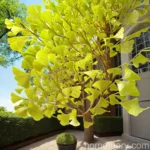Maidenhair Tree (Ginkgo biloba (Pendula Group)
Introduction
The maidenhair tree, scientifically known as Ginkgo biloba (Pendula Group), is a unique and exquisite tree that has garnered attention for centuries due to its extraordinary visual appeal and medicinal properties. The Pendula Group is a cultivated variety of Ginkgo biloba that is highly valued for its graceful, weeping form and distinctive fan-shaped leaves. This blog post aims to delve into the world of maidenhair trees, exploring their culture, uses, care tips, and much more.
What is Plant: Maiden Hair Tree (Ginkgo biloba (Pendula Group)
The maidenhair tree, Ginkgo biloba, is an ancient and distinct tree species that has remained virtually unchanged for over 200 million years. It is the last surviving member of the Ginkgoaceae family, a group of gymnosperms that date back to the Mesozoic era. The species is dioecious, meaning individual trees produce either male or female reproductive structures, commonly referred to as “strobili”. The Ginkgo biloba (Pendula Group) is a particular cultivar of the species known for its elegant weeping habit, making it a notable addition to garden landscapes.
Key Takeaways – Maiden Hair Tree (Ginkgo biloba (Pendula Group)
- Enchanting, weeping habit
- Distinctive fan-shaped leaves
- Dioecious nature
- Resilient and adaptable species
- Medicinal and ornamental uses
Culture
Water
Maidenhair trees generally prefer moist, well-drained soil, especially during their early years of establishment. They are sensitive to waterlogging, which can lead to root rot and other detrimental conditions. Once established, they exhibit good drought tolerance and can thrive in various soil moisture conditions.
Sunlight
Ginkgo biloba (Pendula Group) thrives in full sun to partial shade, displaying optimal growth and foliage development when provided with ample sunlight. However, they can tolerate shade conditions relatively well, making them versatile in various garden settings.
Fertilizer
When it comes to fertilizer, maidenhair trees typically do not have high nutritional demands. A balanced, slow-release fertilizer applied in early spring can sufficiently meet their nutrient requirements. Over-fertilization can lead to excessive vegetative growth and may compromise the tree’s natural form.
Soil
These trees are adaptable to a wide range of soil types, including sandy, loamy, and clay soils, as long as the soil is well-draining. They are known to be tolerant of urban conditions and air pollution, making them suitable for various planting locations.
Uses
Ornamental
The Ginkgo biloba (Pendula Group) is primarily cultivated for its ornamental value, with its elegant weeping form and unique leaves making it a standout feature in any landscape. Its adaptability to urban environments further enhances its desirability as an ornamental tree.
Medicinal
Ginkgo biloba has a long history of medicinal use, particularly in traditional Chinese medicine. The leaves of the maidenhair tree are used to extract ginkgo biloba extract, which is believed to offer various health benefits, including cognitive enhancement and improvement of blood circulation.
Pruning
Pruning maidenhair trees is typically minimal due to their naturally graceful form. Regular removal of dead or damaged branches and light shaping may be required, especially during the tree’s early years, to develop a well-balanced canopy.
Propagation
Propagation of Ginkgo biloba can be achieved via seeds or cuttings. However, it is important to note that trees derived from seeds may not necessarily inherit the weeping characteristics of the Pendula Group. For this reason, propagation through cuttings is often preferred to ensure the preservation of the desirable traits.
Container Popularity
While maidenhair trees can be grown in containers, their large size and extensive root system make it challenging to maintain them as long-term container plants. However, they can be displayed beautifully in large containers during their early growth stages or in specific garden designs.
Common Diseases
Disease Diagnosis
Ginkgo biloba (Pendula Group) is generally resistant to most pests and diseases. However, they may occasionally suffer from leaf spot diseases, which are often caused by fungal pathogens. Adequate spacing, proper air circulation, and avoiding overhead watering can help prevent these issues.
Common Pests
Pest Infestation
Maidenhair trees are relatively resistant to pests, with few known significant insect-related issues. However, aphids and scale insects may occasionally infest these trees. Early detection and timely intervention are critical in managing pest infestations.
Botanist’s Tips
- Ensure proper drainage to prevent waterlogging.
- Avoid over-fertilization to maintain the tree’s natural growth habit.
- Regularly monitor for signs of pest infestations and diseases.
Fun Facts
- Ginkgo biloba is often referred to as a “living fossil” due to its extensive history and lack of close living relatives.
- The seeds of the maidenhair tree are edible after being cooked and are often considered a delicacy in certain cultures.
Links to External Resources
To further enrich your knowledge about maidenhair trees and Ginkgo biloba (Pendula Group), we recommend exploring the following resources:
1. Royal Horticultural Society – Ginkgo biloba: link
2. Missouri Botanical Garden – Ginkgo biloba: link
3. University of Florida IFAS Extension – Ginkgo biloba: link
4. American Horticultural Society – Ginkgo biloba: link
5. The Morton Arboretum – Ginkgo biloba: link
In conclusion, the maidenhair tree, Ginkgo biloba (Pendula Group), stands out as a remarkable addition to any garden or landscape. Its unique form, resilience, and historical significance make it a captivating species worthy of attention and admiration. Whether appreciated for its ornamental beauty or valued for its medicinal properties, the Ginkgo biloba (Pendula Group) continues to captivate plant enthusiasts and researchers alike.















